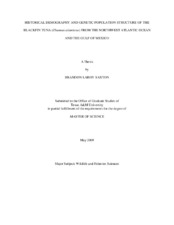| dc.description.abstract | Little is known about the population structure and genetic variability of blackfin
tuna despite catch increases over the past 25 years. In this thesis, levels of genetic
variation contained in 323bp of the mitochondrial DNA (mtDNA) control region-I (CR-I)
and in six microsatellite loci were characterized for two regions: the Gulf of Mexico
(GoM) and the Northwest Atlantic. Large amounts of mtDNA diversity (h>0.99; =0.047)
were observed in both regions. Mismatch distribution analysis of the CR-I sequence
data, using a mutation rate of 1.6% Ma-1for scombroid fishes, indicate blackfin tuna
underwent population expansion about 1.4 Ma, a timeline concordant with the expansion
of other tunas and billfishes. Estimates of female effective population size were very
large at 7.8 million and 12.8 million individuals for the NW Atlantic and the GoM,
respectively.
Both mtDNA and six microsatellite loci were used to determine blackfin tuna
population structure. Microsatellite and mtDNA AMOVAs revealed significant
differentiation (msat st=0.01, p=0.006 and mtDNA st=0.01, p=0.049) between the GoM
and the NW Atlantic samples. Migration estimates using mtDNA data indicate that twice as many females enter the NW Atlantic from the GoM (346
individuals/generation) than the opposite direction (150 individuals/generation).
Migration estimates using microsatellite data were substantially smaller, with the Gulf
receiving 7 individuals/generation and the NW Atlantic 4 individuals/generation.
Finally, low levels of genetic differentiation using microsatellite data have been
reported in other highly abundant marine fishes, which have been attributed to
homoplasy in allele size. To test this hypothesis, the allele frequency distributions of
blackfin and yellowfin tuna at six microsatellite loci were compared. The distances
between species were surprisingly small (Da=4.0%, (delta mu)squared=1.08), with a large degree of
similarity in frequency distributions at four loci. The comparison of bigeye tuna at two
microsatellite loci revealed additional inter-specific similarities. A mutation rate for
these loci was estimated by modifying an equation used to estimate time since
divergence. Microsatellites in tunas appear to evolve at a rate (4.3x10-7 Ma-1) that is two
orders of magnitude slower than other fishes (1x10-5 Ma-1). Accordingly, microsatellite
allele size similarities are plesiomorphic and not due to homoplasy. | en |


